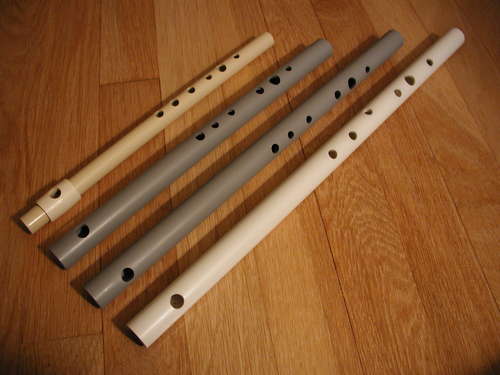
PVC flutes are a cheap way to add an acoustic element to electronic music and also offer the opportunity to explore alternate tunings. For example, ambient artist Robert Rich has used PVC flutes extensively in his music.
This instructable explains how to make simple PVC flutes:
This flute design is a common one on the net, and for good reason. Not only is it simple to build, it’s also relatively simple to learn and rewarding to play. It only took a month of on and of playing to be relatively proficient (meaning I could get a clean sound from the first two octaves without difficulty.) The flutes are keyed instruments and only play in one scale (without more complex fingerings) which is actually a plus when just noodling around since you can’t easily hit a note outside of the major scale of that flutes key.
My G flute can hit about 2 octaves easily and 2.5 octaves if you push it. My D fife can hit 2 octaves. There are already a number of good sites out there on how to make flutes, but I thought I would add some of my experiences making my own flute collection that haven’t been addressed.

is the sound of the flute or key determined by its length ? i like the idea of building my own flue but concerned on just how to define its pitch i can use a tuner to find out but if their is a way to get in the ball park without just guessing .
The original lenght you have to use a tuner for, as for the rest check out this link.
[youtube E7dLyOutCzY http://www.youtube.com/watch?v=E7dLyOutCzY youtube]
The original lenght you have to use a tuner for, as for the rest check out this link.
[youtube E7dLyOutCzY http://www.youtube.com/watch?v=E7dLyOutCzY youtube]
The original lenght you have to use a tuner for, as for the rest check out this link.
[youtube E7dLyOutCzY http://www.youtube.com/watch?v=E7dLyOutCzY youtube]
he knows what's up with his flutes! much help!